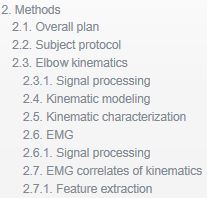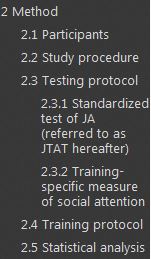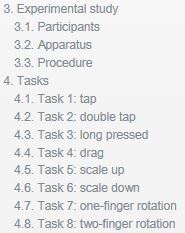 The Materials and Methods section is very different from the Introduction. It’s like a recipe for how the research was conducted. The litmus test of a successful Methods section is “reproducibility“; that is, the reader could replicate the study based on the information provided. (In reality, this standard may be impossible due to factors such as tacit knowledge.) The reader’s confidence that the method seems reproducible is key to achieving credibility.
The Materials and Methods section is very different from the Introduction. It’s like a recipe for how the research was conducted. The litmus test of a successful Methods section is “reproducibility“; that is, the reader could replicate the study based on the information provided. (In reality, this standard may be impossible due to factors such as tacit knowledge.) The reader’s confidence that the method seems reproducible is key to achieving credibility.
The Materials and Methods section is written in the past tense, and includes the “ingredients” of the study (materials) and the process for doing it (methods). At the most basic, a Methods section has three kinds of information: Participants or Subjects (who or what was experimented upon), Instruments (materials and tools used), and Procedure (the steps researchers followed). Citations for studies are indicated in brackets at the ends of examples — all come from the studies found in the table at the end of this page.
 Participants/Subjects/Materials – who or what the experiment acted upon (people, rats, bacteria, chemical, etc), described with appropriate detail
Participants/Subjects/Materials – who or what the experiment acted upon (people, rats, bacteria, chemical, etc), described with appropriate detail
With people, this includes total number of participants and demographic details
“Thirty-six children with ASD (32 M and 4 F, 20 Caucasian, 6 African American, 4 Asian, 3 Hispanic, and 3 of mixed ethnicity) between 5 and 12 years of age (M (SD) = 7.63(2.24)) participated (see Fig. 1 for details of enrollment). Children were recruited through fliers posted online and onsite in local schools, services, and self/parent advocacy groups. Children were enrolled following written parental consent.” [3]
With animals, this includes species and breed, sex, age, and any other distinctive characteristics (e.g. knock-out strains)
“Virgin Sprague-Dawley (SD) rats (age, 12–16 weeks) obtained from BioLASCO Taiwan Co., Ltd. (Taipei, Taiwan) were housed in a facility accredited to the Association for Assessment and Accreditation of Laboratory Animal Care International. The rats were exposed to 12-/12-h light/dark cycle.” [5]
With “materials”, whether biologic or non-biologic, this includes precise identification and where material originated
“Kaolin clay (Tianjin, China) and humic acid (Shanghai, China) were used in preparing water samples. Kaolin clay was prepared by dissolving 50.0 g of kaolin clay in 1 L deionized water under continuous stirring for 24 h…Poly aluminum chloride (PACl; 28% Al2O3), with a basicity of 72.3%, was prepared at 1% concentration by dissolving 5 g reagent in 500 mL deionized water.” [1]
Instruments – materials used to test participants or gather results, including machines, apparatus, software programs as well as descriptions of surveys
“The interaction framework for the experiment was implemented in Java using JMonkeyEngine SDK v.3.0beta. The devices used for deployment and the experiment were a Motorola MZ601 and a Samsung Galaxy Note 10.1 tablet with Android 3.2 both with capacitive multi-touch screens.” [4]
“Goniometric data were sampled at 80 Hz by a data acquisition board (USB 6008, National Instruments, Austin, TX). A custom program written in LabVIEW (National Instruments, Austin, TX) sampled and stored all the data, which was later processed in MATLAB (Mathworks, Natick, MA). Data were low-pass filtered with a 2nd order Butterworth filter with a cut-off frequency of 5 Hz. Full-cycle goniometric data were parsed into individual flexions; a single flexion is an elbow articulation beginning with the arm near full extension (0°) and finishing at a self-determined point near full flexion.” [2]
Procedure – chronological explanation of exactly what researcher did to gather data – includes mention of compensation if any was offered
“Each subject was seated comfortably with his/her right arm supported against gravity in the mechanical arm-supporter and tracker (MAST), which isolates upper limb motion to elbow articulations in the horizontal plane, as described previously [17]. The right elbow rested on the axis of the goniometer to ensure accurate recording of anatomic flexion angle. As subjects practiced flexions, the biceps were probed for the most robust EMG signal. Electrodes were firmly secured to the musculature with medical tape and a Velcro strap. Straps then secured the arm to the MAST. Subjects performed several discrete articulations at the elbow (between 30 and 80 repetitions) while kinematic and EMG data were recorded after receiving the following instructions: “Move as smoothly as you can at a comfortable pace of your choice. Flex and extend through your comfortable range of full motion without hyper-extending or hyper-flexing at the elbow.” Exercises were terminated if fatigue was reported.” [2]
“Pregnant SD rats received regular chow or chow supplemented with 60% fructose during the entire pregnancy and lactation periods [5]. Male offspring were assigned to 4 groups (N = 8−10/group): control, HF, HS, and HF + HS. Male offspring in HS group received NaCl (1%) in drinking water from weaning to 3 months of age. NaCl dose used in this study was based on that used in our previous study [11]. BP was measured in conscious rats at 3, 4, 6, 8, 10, and 12 weeks of age by using an indirect tail-cuff method (BP-2000; Visitech Systems, Inc., Apex, NC, USA) [5]. To ensure accuracy and reproducibility, the rats were acclimated to restraint and tail-cuff inflation for 1 week before the experiment. Three stable measurements were obtained and were averaged. The rats were sacrificed at 12 weeks of age. Heparinized blood samples were collected, and the kidneys were harvested and stored at −80 °C.” [5]
Stylistics Note: The bolded verbs are in passive voice. The underlined verbs are in active voice. BOTH are in the past tense. How do you know when to use active or passive? These examples nicely demonstrate that active voice is used when the participants themselves are doing something. However, when the researchers have done something, passive voice is used. Why? Because using the active voice has two consequences: 1) it may create a longer sentence that adds information the reader already knows (specifically, that the researchers are the ones performing the activity); 2) it shifts the focus away from what is important in the sentence, which is what is happening in the procedure. Passive voice is not evil. However, there are fields such as wildlife resources that do not allow passives anywhere in the writing, even in the Methods where it would make good syntactic sense! For a full discussion, please see [link].
Because research varies so much, you will encounter many different ways of expressing these three parts. Regardless of what the sections are called, these three kinds of information must be explained. The snipped images below illustrate just some of the variety of methods headings across different fields of research.
[1]
|
[2] |
[3]
|
[4]
|
[5] |
Subheadings in the Methods section are a combination of functional headings, such as “Participants” and content headings, such as “2.1 Synthetic Water” which indicate specific details in methods/materials.